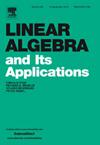Maximum Aα-spectral radius of {C(3,3),C(4,3)}-free graphs
IF 1
3区 数学
Q1 MATHEMATICS
引用次数: 0
Abstract
For a simple graph G and for any , Nikiforov defined the generalized adjacency matrix as , where and are the adjacency and degree diagonal matrices of G, respectively. The largest eigenvalue of is called the generalized adjacency spectral radius (or -spectral radius) of G. Let denote the graph obtained from and by superimposing an edge of with an edge of . If a graph is free of both and , we call it a -free graph. In this paper, we give a sharp upper bound on the -spectral radius of -free graphs for . We show that the extremal graph attaining the bound is the 2-partite Turán graph.
求助全文
约1分钟内获得全文
求助全文
来源期刊
CiteScore
2.20
自引率
9.10%
发文量
333
审稿时长
13.8 months
期刊介绍:
Linear Algebra and its Applications publishes articles that contribute new information or new insights to matrix theory and finite dimensional linear algebra in their algebraic, arithmetic, combinatorial, geometric, or numerical aspects. It also publishes articles that give significant applications of matrix theory or linear algebra to other branches of mathematics and to other sciences. Articles that provide new information or perspectives on the historical development of matrix theory and linear algebra are also welcome. Expository articles which can serve as an introduction to a subject for workers in related areas and which bring one to the frontiers of research are encouraged. Reviews of books are published occasionally as are conference reports that provide an historical record of major meetings on matrix theory and linear algebra.

 求助内容:
求助内容: 应助结果提醒方式:
应助结果提醒方式:


